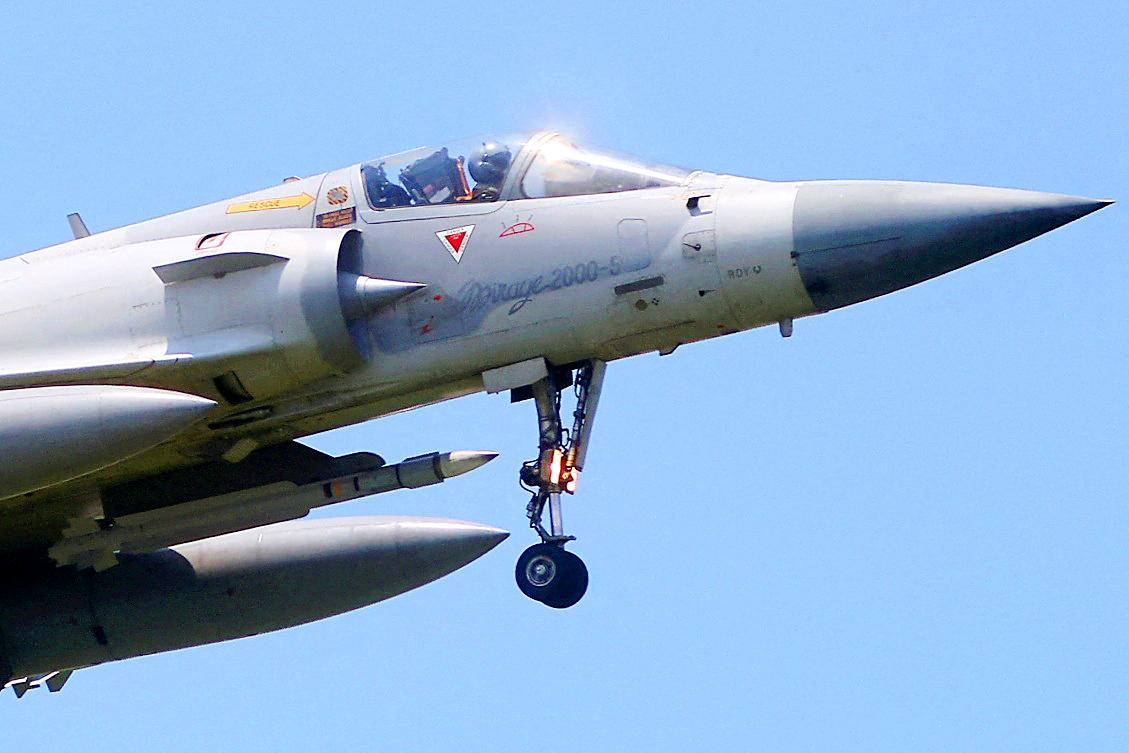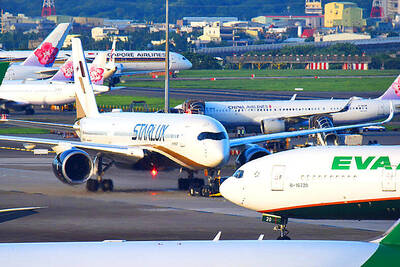If any war were to break out between the US and China, one trigger might be the increasingly frequent fighter jet encounters near Taiwan.
Almost every day, Taiwanese fighter pilots hop in their US-made F-16s to intercept Chinese warplanes screaming past their territory. The encounters probe the nation’s defenses and force the pilots on both sides to avoid mistakes that could lead to a crisis that spins out of control.
“I didn’t know whether they would fire at me,” said retired colonel Mountain Wang, recounting a tense five-minute confrontation he had with Chinese People’s Liberation Army (PLA) jets more than a decade ago. “You have to be highly alert and not lead to any accident with unintended consequences.”

Photo: Ann Wang, Reuters
The risk is even higher now and not just because China is sending more jets with more experienced pilots ever closer to Taiwan proper.
On Wednesday, 27 Chinese military aircraft flew into Taiwan’s air defense identification zone, of which 22 crossed the median line of the Taiwan Strait, the Ministry of National Defense said.
The incursions took place a day before the launch of China’s live-fire military drills in six maritime areas near Taiwan, widely seen as retaliation for a visit by US House of Representatives Speaker Nancy Pelosi to Taiwan earlier last week.
The PLA fired 11 missiles into waters near Taiwan on Thursday, the ministry said, as part of China’s most provocative exercises in decades.
However, a longer-term problem for Taiwan’s military is its dire shortage of pilots. While Taipei is protected by a relatively large and modern fleet of fighter jets, the nation could need as many as 50 years at the current rate to train enough pilots to fill the cockpits of the jets they expect to get by the middle of this decade.
Taiwan might not have that kind of time.
US military commanders estimate Chinese President Xi Jinping (習近平) might have the capability to take action across the Taiwan Strait in as soon as five years, and the daily incursions are wearing down Taiwan’s pilots and the jets they fly.
The shortage illustrates the limits of Taipei’s reliance on purchases of US military hardware to deter the threat of invasion by Beijing. Taiwan would need to add at least 100 more pilots by 2026 to operate the 66 more advanced Lockheed Martin F-16Vs that President Tsai Ing-wen (蔡英文) agreed to buy two years ago.
ONLY 21 NEW PILOTS
The air force only netted 21 new F-16 pilots from 2011 to 2019, according to data compiled by the Taiwan People’s Party (TPP).
“Taiwan has put a lot of emphasis on military preparation,” TPP Legislator Jang Chyi-lu (張其祿) said. “A bigger problem, though, is who can fly the planes?”
Ukraine’s own months-long struggle to turn back Russia’s invasion has highlighted the challenge facing Taiwan’s strategic planners. Although Kyiv has received a huge influx of Western-made military hardware, it has also benefited from having a large reserve of relatively well-trained military personnel.
Taiwan’s effort to attract and train more pilots has been thwarted by a series of factors, from the nation’s declining birthrate to several high-profile crashes. About 80 percent of university students in Taiwan have myopia, due to long classroom hours and high-levels of screen time on electronic devices.
Taiwanese authorities say Ukraine’s success in denying air superiority to a much larger invading power has helped recruiting.
In March, 70 percent of 1,076 people polled by the Taiwan International Strategic Study Society said they were willing to go to war to defend their nation from Beijing’s attack, up from 40 percent in December last year.
Chiang Ming-chun, 18, said he was determined to be an air force pilot despite concerns about the safety risks and increased tensions with China.
“They asked me why not pick army or navy, why does it have to be air force? I just told my parents it is my ambition,” said Chiang, who would be a freshman at the Air Force Academy this year. “If I don’t do it now, I’ll regret why I didn’t chase my dream.”
That renewed determination to sign up was evident last month at the Seventh Flight Training Wing on the Chihhang Air Base in Taitung. The base, located on the Pacific coast, is to house the new F-16Vs, as well as 33 locally developed Yung Ying (勇鷹, “Brave Eagle”) Advanced Jet Trainers by 2024.
‘TOP GUN’ BOOST
Matt Shen, an instructor at the facility, said the release of Top Gun: Maverick — in which Tom Cruise can be seen sporting a Taiwanese flag patch on his jacket — has also driven new applicant interest.
“We think recruiting should be easier in the next two years because Top Gun is so popular,” Shen said, adding: “Many young men dream of flying.”
More than half of the 70 to 80 trainees annually at the center are now being sent to the F-16 wing, Shen said, compared with one-third a few years ago, due to an effort to deal with China’s increased military activity.
PLA aircraft made about 960 forays into Taiwan’s air defense identification zone last year, compared with about 380 in 2020, ministry data showed.
Such encounters are not just shows of power: Forcing Taiwan to drive away warplanes delays its ability to train new fighter pilots, depleting the nation’s capacity to respond in a real conflict.
The air force acknowledged in a statement that the pressure from China was “severe,” but said its capacity to respond had “never slackened.”
“The air force is actively increasing recruits, raising the distribution ratio of pilots to F-16 fleet and enhancing staff’s willingness to stay, and these measures are able to satisfy demands for future pilots,” it said.
LOWER GRADES
Flying schools have begun accepting trainees with lower academic grades to ensure they get more candidates who meet both the physical fitness and vision requirements. The air force has also made it easier for them to sign up in recent years, relaxing rules requiring 20-20 vision and offering corrective eye surgery to some.
Moreover, the busy schedule prevents experienced pilots from helping train new ones. Taiwan requires 250 hours of flight training before a pilot can fly a fighter jet like the F-16.
The Taiwanese military has also seen four air crashes this year, including a fatal one involving an F-16 in January. In May, an air force trainer jet also crashed, killing its pilot.
Chang Yan-ting (張延廷), a former vice chief commander of the air force, said that “insufficient training” was a contributing factor to such incidents.
“The crashes we have seen in air force in the past few years were just the tip of the iceberg, and the situation is expected to get worse in future,” he said.
Still, Shen said his own son also plans to become an air force pilot.
He is not deterred that his son is signing up despite the growing risk of a close encounter with a Chinese warplane.
“I encourage him to do so,” Shen said. “I’m not worried about death. Who can avoid death if a war breaks out? We are at the front line, and it’s our mission to guard the country.”

Trips for more than 100,000 international and domestic air travelers could be disrupted as China launches a military exercise around Taiwan today, Taiwan’s Civil Aviation Administration (CAA) said yesterday. The exercise could affect nearly 900 flights scheduled to enter the Taipei Flight Information Region (FIR) during the exercise window, it added. A notice issued by the Chinese Civil Aviation Administration showed there would be seven temporary zones around the Taiwan Strait which would be used for live-fire exercises, lasting from 8am to 6pm today. All aircraft are prohibited from entering during exercise, it says. Taipei FIR has 14 international air routes and

Taiwan lacks effective and cost-efficient armaments to intercept rockets, making the planned “T-Dome” interception system necessary, two experts said on Tuesday. The concerns were raised after China’s military fired two waves of rockets during live-fire drills around Taiwan on Tuesday, part of two-day exercises code-named “Justice Mission 2025.” The first wave involved 17 rockets launched at 9am from Pingtan in China’s Fujian Province, according to Lieutenant General Hsieh Jih-sheng (謝日升) of the Office of the Deputy Chief of the General Staff for Intelligence at the Ministry of National Defense. Those rockets landed 70 nautical miles (129.6km) northeast of Keelung without flying over Taiwan,

City buses in Taipei and New Taipei City, as well as the Taipei MRT, would on Saturday begin accepting QR code payments from five electronic payment providers, the Taipei Department of Transportation said yesterday. The new option would allow passengers to use the “transportation QR code” feature from EasyWallet, iPass Money, iCash Pay, Jkopay or PXPay Plus. Passengers should open their preferred electronic payment app, select the “transportation code” — not the regular payment code — unlock it, and scan the code at ticket readers or gates, General Planning Division Director-General Liu Kuo-chu (劉國著) said. People should move through the

The Ministry of National Defense (MND) today released images of the military tracking China’s People's Liberation Army (PLA) movements during the latest round of Chinese drills around Taiwan. The PLA began "Justice Mission 2025" drills today, carrying out live-fire drills, simulated strikes on land and maritime targets, and exercises to blockade the nation's main ports. The exercises are to continue tomorrow, with the PLA announcing sea and air space restrictions for five zones around Taiwan for 10 hours starting from 8:30am. The ministry today released images showing a Chinese J-16 fighter jet tracked by a F-16V Block 20 jet and the